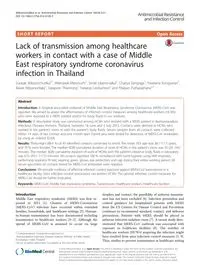
2016 Lack of transmission among healthcare workers in contact with a case of Middle East respiratory syndrome coronaviru PDF
Preview 2016 Lack of transmission among healthcare workers in contact with a case of Middle East respiratory syndrome coronaviru
SHORT REPORT Open Access Lack of transmission among healthcare workers in contact with a case of Middle East respiratory syndrome coronavirus infection in Thailand Surasak Wiboonchutikul1*, Weerawat Manosuthi1, Sirirat Likanonsakul1, Chariya Sangsajja1, Paweena Kongsanan1, Ravee Nitiyanontakij1, Varaporn Thientong1, Hatairat Lerdsamran2 and Pilaipan Puthavathana2,3 Abstract Introduction: A hospital-associated outbreak of Middle East Respiratory Syndrome Coronavirus (MERS-CoV) was reported. We aimed to assess the effectiveness of infection control measures among healthcare workers (HCWs) who were exposed to a MERS patient and/or his body fluids in our institute. Methods: A descriptive study was conducted among HCWs who worked with a MERS patient in Bamrasnaradura Infectious Diseases Institute, Thailand, between 18 June and 3 July 2015. Contacts were defined as HCWs who worked in the patient’s room or with the patient’s body fluids. Serum samples from all contacts were collected within 14 days of last contact and one month later. Paired sera were tested for detection of MERS‐CoV antibodies by using an indirect ELISA. Results: Thirty-eight (88.4 %) of 43 identified contacts consented to enroll. The mean (SD) age was 38.1 (11.1) years, and 79 % were females. The median (IQR) cumulative duration of work of HCWs in the patient’s room was 35 (20–165) minutes. The median (IQR) cumulative duration of work of HCWs with the patient’s blood or body fluids in laboratory was 67.5 (43.7–117.5) minutes. All contacts reported 100 % compliance with hand hygiene, using N95 respirator, performing respirator fit test, wearing gown, gloves, eye protection, and cap during their entire working period. All serum specimens of contacts tested for MERS-CoV antibodies were negative. Conclusions: We provide evidence of effective infection control practices against MERS-CoV transmission in a healthcare facility. Strict infection control precautions can protect HCWs. The optimal infection control measures for MERS-CoV should be further evaluated. Keywords: MERS-CoV, Middle East respiratory syndrome, Transmission, Healthcare workers, Healthcare facilities Introduction Middle East respiratory syndrome (MERS) was first re- ported in 2012 [1]. Clusters of MERS-Coronavirus (MERS-CoV) infection have occurred within extended families, households, and healthcare settings [2]. Human- to-human transmission has been documented including transmission to healthcare workers [3–5]. Although the spread of MERS-CoV is assumed to occur via large droplets and contact, the possibility of airborne transmis- sion has not been excluded [6]. Infection prevention and control guidance for hospitalized patients with MERS from the US Centers for Disease Control and Prevention continues to recommend standard, contact, and airborne precautions. Patients with MERS should be placed in airborne infection isolation room [7]. A recent study dem- onstrated that MERS-CoV outbreak was associated with exposure to healthcare facilities [8]. The number of healthcare workers (HCWs) acquiring the infection might have resulted from poor infection control measures [5, 9]. Thus, studies to prevent transmission in healthcare setting * Correspondence:
